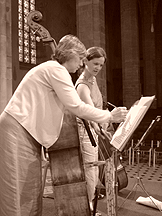A Modest Proposal
|
Number 26 A Modest Proposal |
|
Dodging brickbats … Consumer Reports purchases what it covers, thereby avoiding suspicions of collusion. Elsewhere, reviewers who anger manufacturers find themselves cut off from stuff to write about. That’s why I propose to tread lightly, especially since this little stroll into cyberspace isn’t about audio hardware, at least not directly. So then: Immediately below, for your delight and edification, are cable prices from a highly regarded audio company whose products I have used with pleasure, tho I’ve not tried these, nor am I likely to: One-meter interconnect, $15,999 / pair. Together that comes to about $56k, and you’ll surely require more than the three listed here. Scarcely shocking. Audiophilia’s gentry takes in its stride prices mere groundlings regard as insane. “It’s all about the music.” One would hope so. Hey, big spender… Which brings us to the music it’s all about. However acclimated the audiophile is to extravagant prices, few of us are likely to spend a multiple of $56k on cabling. We’re equally unlikely to spring for a 27-volume recording project that goes for around $900. We just don’t spent that much at one time on one stack of related discs. But how many of us have spent $900 or more on interconnects or a line conditioner – you know, the goods that get us closer to the music.
Where am I going with this? Directly to a suggestion: that you set aside a small part of your life-is-good budget and buy this extravagance in its entirety. Within it, in equal measure, reside discovery and joy. There’s insanity, and then there’s insanity This isn’t just any old recording project. Normally, musicians perform a composer’s collected whatevers in one space under one set of time constraints and acoustic conditions. I’ve been listening most recently to volume 18. The venues for the two discs’ seven works are given as the Henderkirche in Weimar, the Nikolaikirche in Leipzig, and Hauptkirche St. Jacobi in Hamburg. All in all, our musical caravan rehearsed, performed and recorded in churches and cathedrals in Germany, England, France, Switzerland, Austria, Spain, the Netherlands, and finally, to celebrate Christmas and the New Year, in St. Bartholomew’s in Manhattan. While the project’s last volume appeared a few months ago, the project itself, which its conductor and sponsors characterize as a pilgrimage, occurred between 1999 and the start of 2000. Why the need for a hectic travel, arrival, rehearsal, performance and recording schedule in so very many houses of worship remains, for me at least, a mystery. But certainly not a deterrence. In any event, a band of instrumentalists, choristers and shifting roster of vocal soloists – not a clunker in the lot – perform and record most of Johann Sebastian Bach’s surviving church cantatas, something under two hundred. An indeterminate number have been lost, and the reason why is not difficult to understand. They are, to use the term in its literal sense, occasional pieces – music for a specific occasion – to be performed and put aside. The cantatas, among other tasks and duties, were on Bach’s to-do list. They’re what he contracted to compose, as required, to keep family and reputation intact. In addition to composing and performing – Bach was celebrated in his time as a virtuoso organist – he produced a brood of kids, several of whom went on to become important composers in their own right. Why the fuss? And now we come to the miracle, or if you prefer, examples of overwhelming genius.
Given the size of his faith’s liturgical calendar, you’d think that Bach would have cranked out his cantatas like so much lookalike wurst. All you need do to disabuse yourself of that assumption is to play any one of these CDs through. If beauty’s your thing, you’re guaranteed encounters of sweetness, glory and brilliance. Being in no way authoritative, indeed, having heard in my lifetime fewer than half the existing total, I’ve played this game on myself and have come away astonished. My pleasure looks in large measure to the performances’ unremitting quality. If your take on the music is as imperfectly focused as mine, I suggest acquiring the 27 volumes if only to open doors to perception.
The elegant volumes are packaged as little books, the covers of which feature atmospheric photo-portraits by Steve McCurry of people in non-Western garb, as symbolic perhaps of the music’s universality. I’ve seen few recording projects as handsomely presented. A checkered history Gardiner began recording the cantatas under Deutsche Grammophon’s Archiv imprint. I have eleven of those single-disc releases, a quick check of which reveals that these Soli Deo Gloria volumes do not repeat much of the Archiv’s contents. Why Archiv dropped out I cannot say. In any event, the Archiv CDs share the SDG project’s wanderlust. It would seem that the pilgrimage, then not so identified, began before SDG, Gardiner’s own label, took over. Eccentricities need not be goofy I mentioned the pilgrimage as a tad peculiar. Arduous certainly. As a further peculiarity, the volumes have not appeared consecutively, the first, for example, showing up after the sets began appearing over the course of many months. Notwithstanding Prince Charles’ support, I suspect the delays had to do with funding. All of which means little when the epiphanies burst into blossom.
ArkivMusic.com, among other classical-music vendors, handles Soli Deo Gloria For information, www.solideogloria.co.uk
|
| Don’t forget to bookmark us! (CTRL-SHFT-D)
|
Stereo Times Masthead
Publisher/Founder
Clement Perry
Editor
Dave Thomas
Senior Editors
Frank Alles, Mike Girardi, Russell Lichter, Terry London, Moreno Mitchell, Paul Szabady, Bill Wells, Mike Wright, and Stephen Yan,
Current Contributors
David Abramson, Tim Barrall, Dave Allison, Ron Cook, Lewis Dardick, John Hoffman, Dan Secula, Don Shaulis, Greg Simmons, Eric Teh, Greg Voth, Richard Willie, Ed Van Winkle, Rob Dockery, Richard Doran, and Daveed Turek
Site Management Clement Perry
Ad Designer: Martin Perry






 Among casual music lovers, Bach is best known for his Brandenburg Concertos, B-Minor Mass, Musical Offering, Art of the Fugue, Magnificat, Toccata and Fugue in D Minor for organ, the Well-Tempered Klavier, and a number of other widely recorded works. As a church employee, he was required to produce cantatas for the Lutheran calendar’s feast days. Thanks largely to Beethoven, it wasn’t until the 19th century that audiences deposited composers on pedestals. Bach and his contemporaries were more on the order of master craftsman who worked for the church – in Bach’s case, Lutheran – the nobility, and an increasingly powerful middle class.
Among casual music lovers, Bach is best known for his Brandenburg Concertos, B-Minor Mass, Musical Offering, Art of the Fugue, Magnificat, Toccata and Fugue in D Minor for organ, the Well-Tempered Klavier, and a number of other widely recorded works. As a church employee, he was required to produce cantatas for the Lutheran calendar’s feast days. Thanks largely to Beethoven, it wasn’t until the 19th century that audiences deposited composers on pedestals. Bach and his contemporaries were more on the order of master craftsman who worked for the church – in Bach’s case, Lutheran – the nobility, and an increasingly powerful middle class.  The conductor, John Eliot Gardiner, annotated these volumes – an informative delight. Producer Isabella de Sabata and her recording teams did an especially fine job of optimizing the project’s dozens of venues. Gardiner’s English Baroque Soloists and Monteverdi Choir are just what you’d expect of the cream of British players and singers. Years ago a Swedish producer told me that a good British orchestra can sight-read a difficult score as if it had been lengthily rehearsed. The British choral tradition needs no word from me.
The conductor, John Eliot Gardiner, annotated these volumes – an informative delight. Producer Isabella de Sabata and her recording teams did an especially fine job of optimizing the project’s dozens of venues. Gardiner’s English Baroque Soloists and Monteverdi Choir are just what you’d expect of the cream of British players and singers. Years ago a Swedish producer told me that a good British orchestra can sight-read a difficult score as if it had been lengthily rehearsed. The British choral tradition needs no word from me. 



Be the first to comment on: A Modest Proposal